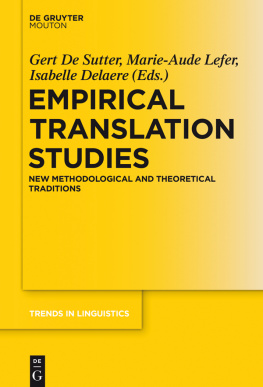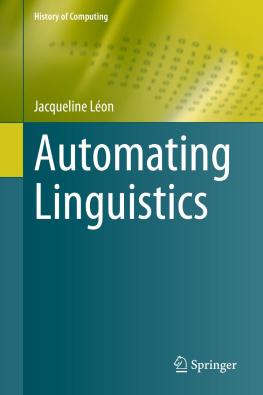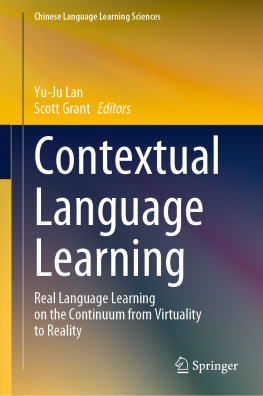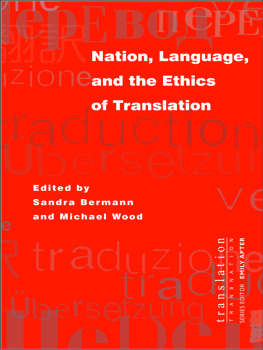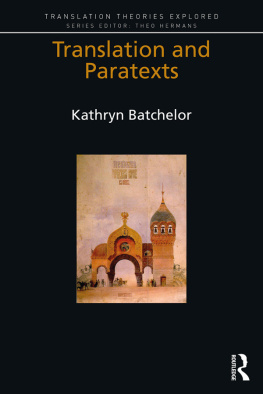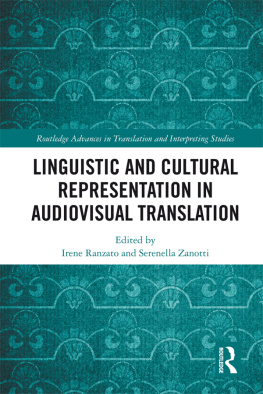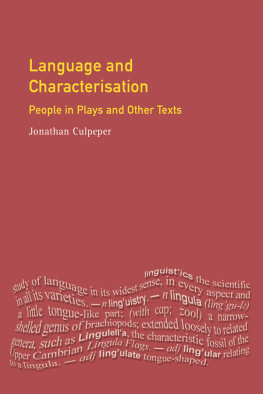Gert De Sutter - Empirical Translation Studies
Here you can read online Gert De Sutter - Empirical Translation Studies full text of the book (entire story) in english for free. Download pdf and epub, get meaning, cover and reviews about this ebook. year: 2017, publisher: De Gruyter Mouton, genre: Home and family. Description of the work, (preface) as well as reviews are available. Best literature library LitArk.com created for fans of good reading and offers a wide selection of genres:
Romance novel
Science fiction
Adventure
Detective
Science
History
Home and family
Prose
Art
Politics
Computer
Non-fiction
Religion
Business
Children
Humor
Choose a favorite category and find really read worthwhile books. Enjoy immersion in the world of imagination, feel the emotions of the characters or learn something new for yourself, make an fascinating discovery.
- Book:Empirical Translation Studies
- Author:
- Publisher:De Gruyter Mouton
- Genre:
- Year:2017
- Rating:4 / 5
- Favourites:Add to favourites
- Your mark:
- 80
- 1
- 2
- 3
- 4
- 5
Empirical Translation Studies: summary, description and annotation
We offer to read an annotation, description, summary or preface (depends on what the author of the book "Empirical Translation Studies" wrote himself). If you haven't found the necessary information about the book — write in the comments, we will try to find it.
Empirical Translation Studies — read online for free the complete book (whole text) full work
Below is the text of the book, divided by pages. System saving the place of the last page read, allows you to conveniently read the book "Empirical Translation Studies" online for free, without having to search again every time where you left off. Put a bookmark, and you can go to the page where you finished reading at any time.
Font size:
Interval:
Bookmark:

Gert De Sutter, Marie-Aude Lefer, Isabelle Delaere (Eds.)
Empirical Translation Studies

Editor
Volker Gast
Editorial Board
Walter Bisang
Jan Terje Faarlund
Hans Henrich Hock
Natalia Levshina
Heiko Narrog
Matthias Schlesewsky
Amir Zeldes
Niina Ning Zhang
Editor responsible for this volume
Volker Gast
Volume 300

ISBN 978-3-11-045684-4
e-ISBN (PDF) 978-3-11-045958-6
e-ISBN (EPUB) 978-3-11-045729-2
ISSN 1861-4302
Library of Congress Cataloging-in-Publication Data
A CIP catalog record for this book has been applied for at the Library of Congress.
Bibliographic information published by the Deutsche Nationalbibliothek
The Deutsche Nationalbibliothek lists this publication in the Deutsche Nationalbibliografie; detailed bibliographic data are available on the Internet at http://dnb.dnb.de.
2017 Walter de Gruyter GmbH, Berlin/Boston
www.degruyter.com
Gert De Sutter, Marie-Aude Lefer and Isabelle Delaere
In corpus-based translation studies (CBTS), many scholars have conducted research based on the hypothesis that translated texts have certain linguistic characteristics in common which do not, or to a lesser extent, occur in original, non-translated texts. Bakers (1993) seminal paper described these characteristics as features which typically occur in translated text rather than original utterances and which are not the result of interference from specific linguistic systems (Baker 1993: 243). Research of this kind has resulted in observations of, for example, how translations conform to the typical characteristics of the target language (normalization) (Bernardini and Ferraresi 2011; Scott 1998), how translated texts are linguistically more homogeneous than non-translated texts (levelling out) (Olohan 2004), how translated texts are more explicit than non-translated texts (explicitation) (Olohan and Baker 2000; vers 1998) or how translated texts exhibit fewer unique items (under-representation) (Tirkkonen-Condit 2004). In recent years, however, it has been shown that these detected characteristics are not only attributable to the difference between translated and non-translated texts, but co-vary with other (language-external) factors as well, such as text type, source language and the translators educational background (see e.g. Bernardini and Ferraresi 2011; De Sutter, Delaere, and Plevoets 2012; Kruger and van Rooy 2012; Neumann 2011). As a consequence, linguistic behaviour in translations versus non-translations has to be considered a multifactorial phenomenon rather than a monofactorial one. Multifactorial investigations into the linguistic behaviour of translators compared to non-translators remain rather scarce though, and, as a result, standard multivariate statistical techniques which can be used to visualize, describe, explain and predict patterns of variation within translations and between translations and non-translations do not easily find their way into CBTS (e.g. multidimensional scaling, hierarchical cluster analysis, mixed-effect models). This type of multifactorial investigation, using highly advanced and adequate statistical techniques, is urgently needed in order to find out which factors simultaneously affect linguistic behaviour in translations compared to non-translations. Next to the (language-external) factors mentioned above, other possibly influencing factors include characteristics of the writing process (did the translator use translation software?, did the translator experience any time pressure?, what is the degree of editorial control?, what is the policy of the publishing house?), typological or usage differences between source and target languages, the sociological status of the source and target languages, the style of the translator or original author, the sociological status of different types of translators, etc.
Whereas the identification of the determining factors is a necessary first step to take, the ultimate goal of CBTS is to find out what these factors reveal on a higher level about underlying sociological, cognitive,... causes and motivations of linguistic choices in translations vs. non-translations. In recent years, several interesting high-level explanatory mechanisms have been developed, from different perspectives, but they have not been the object of extensive empirical testing yet. From a sociological point of view, Pym (2008) has introduced the idea of translators being risk averse: if they can choose between a safe option (e.g. a variant that is widely accepted as a standard variant), and a risky option (e.g. a variant that is considered restricted to informal conversations), translators will most often opt for the former option, depending on whether they get rewarded or not when taking a risk. From a cognitive point of view, Halverson (2003, 2010) has introduced the so-called gravitational pull hypothesis, which seeks to connect translation behaviour with underlying cognitive properties, such as salience and activation. The gravitational pull hypothesis states that translation characteristics such as under-representation can be explained by the structure of semantic networks and prototypes, i.e. the distance between the activated concepts in the semantic network of the bilingual or multilingual translator.
The present volume aims to push the frontiers of CBTS by presenting original and innovative research which is methodologically rigorous, descriptively adequate and theoretically relevant. Each of the chapters sheds new light on what constrains translational behavior and to what extent and how this all fits in an empirical theory of translation. More particularly, this books aim is twofold: (i) to bring together advanced quantitative (multifactorial) studies of translated texts (compared to non-translated texts on the one hand and/or source texts on the other hand), building on large-scale, well-structured parallel or comparable corpora, which provide additional evidence for the effect of (language-external) factors on translation behavior, resulting in more fine-grained insights into translational tendencies, and which elaborate on explanatory devices uncovered in previous studies; (ii) to investigate to what extent other, complementary methods from related research fields or new data sources can improve the descriptive and explanatory accuracy of corpus-based results. By embracing other, complementary methods aiming at descriptive and theoretical progress, the field of Corpus-Based Translation Studies will eventually emerge as Empirical Translation Studies, in which different methods and models are confronted, ultimately leading to a more adequate and fully-fledged empirical theory of translation.
Sandra Halverson s chapter is exemplary for the type of new-generation research envisaged in the previous paragraph, viz. theory-based, methodologically pluralistic and improving our understanding of the translational act. Starting out from a well-informed cognitive-linguistic model of bilingual language processing, Halverson investigates how translators deal with semasiological salience, using so-called converging empirical evidence (corpus data and elicited data). She distinguishes between three different types of salience, which might cause translations to be linguistically different from non-translations: a magnetism effect occurs when a translator is attracted to a prominent sense in the target language, a gravitational pull effect occurs when a translator is attracted to a prominent sense in the source language, and an effect of association strength occurs when two senses in the source and target language are often used as translational equivalents. In order to test which of these effects occur under which circumstances, Halverson develops a multi-stage and multi-methodological research design. First, an independent sentence generation test and a semasiological contrastive corpus analysis of the English polysemous verb to get and two of its Norwegian equivalents f and bli are conducted in order to establish a semantic network of these verbs, elucidating which senses are more salient and how strong the connection between the translation equivalents is. Then, a corpus analysis of Norwegian fiction and non-fiction translated into English is carried out in order to determine which of the above-mentioned salience effects occur. Her results show a.o. a clear magnetism effect for one of get s most prominent senses, but other hypothesized effects remain unverified. Finally, an online keystroke experiment reveals that salience also affects revision behavior in that highly frequent verbs tend to be replaced more often than low frequent verbs during later stages of the translation process. Although much more research is needed along the lines sketched in this chapter, the research presented here clearly demonstrates how the effect of bilingual cognition can be studied within an empirical translation framework.
Font size:
Interval:
Bookmark:
Similar books «Empirical Translation Studies»
Look at similar books to Empirical Translation Studies. We have selected literature similar in name and meaning in the hope of providing readers with more options to find new, interesting, not yet read works.
Discussion, reviews of the book Empirical Translation Studies and just readers' own opinions. Leave your comments, write what you think about the work, its meaning or the main characters. Specify what exactly you liked and what you didn't like, and why you think so.

